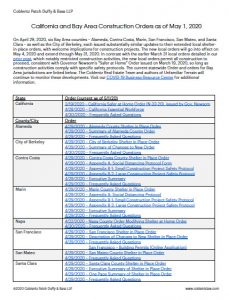On April 29, 2020, six Bay Area counties – Alameda, Contra Costa, Marin, San Francisco, San Mateo, and Santa Clara – as well as the City of Berkeley, each issued substantially similar updates to their extended local shelter-in-place orders, with welcome implications for construction projects. The new local orders will go into effect on May 4, 2020 and extend through May 31, 2020.
In contrast with the earlier March 31 local orders detailed in our prior post, which notably restricted construction activities, the new local orders permit all construction to proceed, consistent with Governor Newsom’s “Safer at Home” Order issued on March 19, 2020, so long as construction activities comply with specific safety protocols.
It is critical that contractors comply with the specific Construction Project Safety Protocols applicable to their projects. In particular, the new local orders distinguish between protocols for small projects, which mean projects of ten (10) or fewer residential units or commercial projects with less than 20,000 square feet, and separate protocols for larger projects. While the protocols for small and larger projects are each designed to encourage social distancing and establish procedures to minimize the spread of COVID-19, the protocols for larger projects are generally more detailed and restrictive.
Other Bay Area counties – Napa, Solano, and Sonoma – have issued their own orders generally permitting construction to continue. Napa County’s April 22 order permits construction (including housing construction) to proceed, so long as contractors follow its specific “Construction Site Requirements.” Solano County’s April 24 order is consistent with the State’s Order regarding construction activities. Last, as of the date of this alert, Sonoma County has not updated its March 31 order but is expected to issue guidance ahead of its expiration on May 3, 2020. Regardless of location, all construction activities in California should comply with the Cal/OSHA guidance for COVID-19 Infection Prevention in Construction, in addition to the specific protocols in each local order.
As a practical consideration, since the new local orders will jump start a large volume of construction projects across the Bay Area, the availability of public agency staff to perform permit reviews and inspections may constrain construction progress in the short term.
While the new local orders assert that they seek regional clarity and a better alignment with the State’s Order, clients should recognize that different project and local considerations could impact how each jurisdiction interprets and regulates its respective order. Where a conflict exists between any of the local orders and the State’s Order, the most restrictive provision controls.
 Local health officers are carefully monitoring the evolving COVID-19 status in their respective jurisdictions and could change local restrictions as necessary. The State may also issue additional guidance. The current State Order and local orders for Bay Area jurisdictions are linked to the left.
Local health officers are carefully monitoring the evolving COVID-19 status in their respective jurisdictions and could change local restrictions as necessary. The State may also issue additional guidance. The current State Order and local orders for Bay Area jurisdictions are linked to the left.
The Coblentz Real Estate team and authors of our real estate and land use blog, Unfamiliar Terrain, will continue to monitor these developments. Visit our COVID-19 Business Resource Center for additional information, or contact Real Estate attorneys Tay Via at tvia@coblentzlaw.com.

